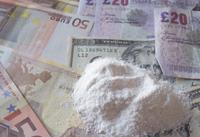Heroin-contaminated banknotes can be identified quickly and cleanly using tandem mass spectrometry, report chemists at the University of Bristol, UK.
Heroin-contaminated banknotes can be identified quickly and cleanly using tandem mass spectrometry, report chemists at the University of Bristol, UK.

Drug traffickers are often not in possession of the drugs they push, so customs officers require a link between the two from other items in their possession. Banknotes often become contaminated during drug deals, with contaminants found at higher concentrations than on the banknotes in general circulation, according to the Bristolteam.
Diacetylmorphine (DAM), the major active constituent of heroin, shows up in two peaks of product ions at m/z 328 and 268, with a ratio of intensities between the two peaks that should fall within certain parameters. Using a log transformation of the data with a higher proportion of contamination, the researchers found that 2-3 per cent of banknotes in general UK circulation were contaminated with DAM traces.
Previous techniques were based on solvent extraction or the collection of surface particles on filters. Clean-up procedures followed by gas chromatography/mass spectrometry were then required. These time-consuming techniques left cases open to criticism as they were applied to bundles of banknotes, and defendants argued that they were in possession of only one contaminated banknote. Individual analysis of each banknote was very time consuming.
The tandem MS/MS technique works by partially introducing individual banknotes - so as to retain some of each note as evidence - into a slot between two heated metal blocks. Thermally desorbed materials are carried by an ambient air stream into the source region of an atmospheric pressure chemical ionisation (APCI) MS/MS.
The technique is much quicker than existing procedures, claim the researchers. About 100-200 banknotes can be analysed per 20-minute analytical run, they say, letting scientists analyse greater numbers of individual banknotes for contamination. Fiona Salvage
References
K A Ebejer et alRapid Communications in Mass Spectrometry, 2005, 19, 2137






No comments yet